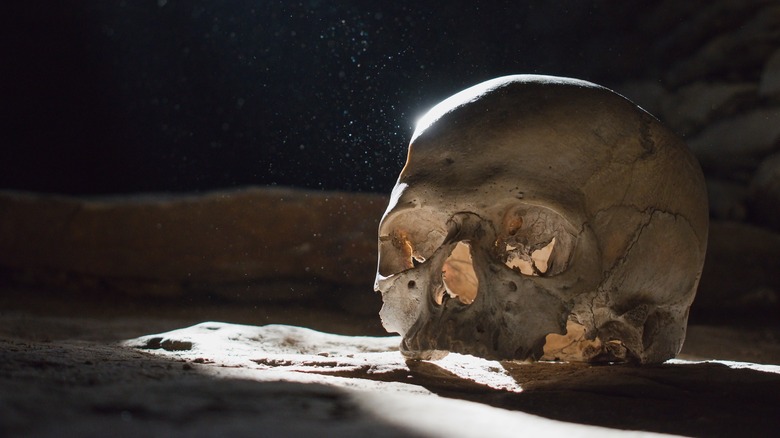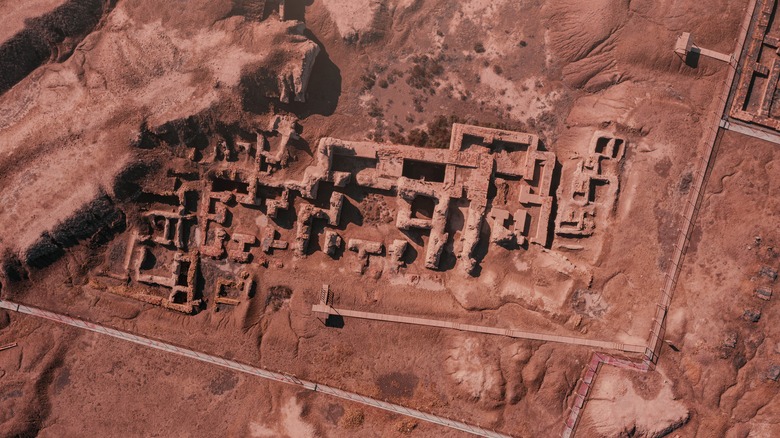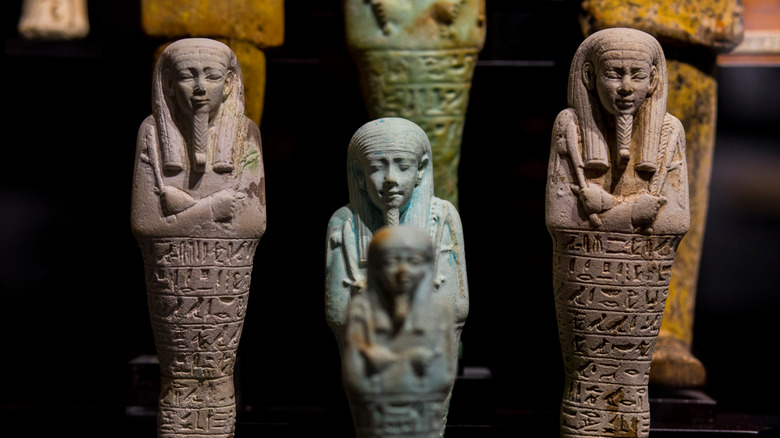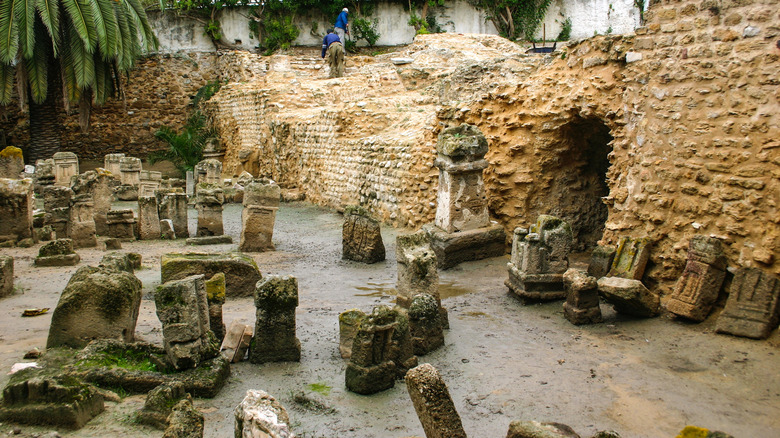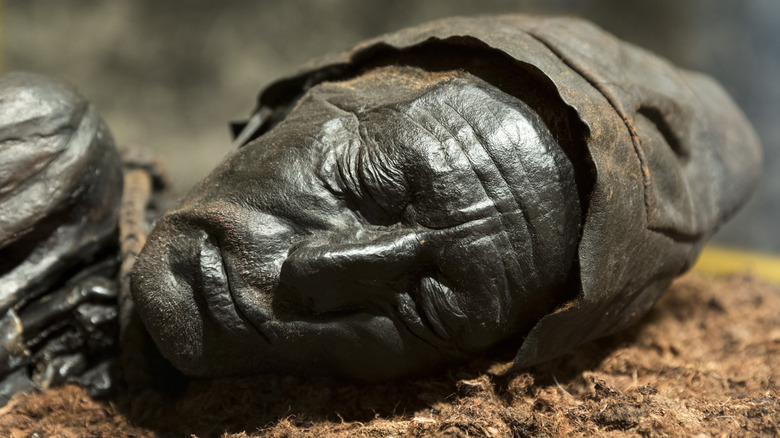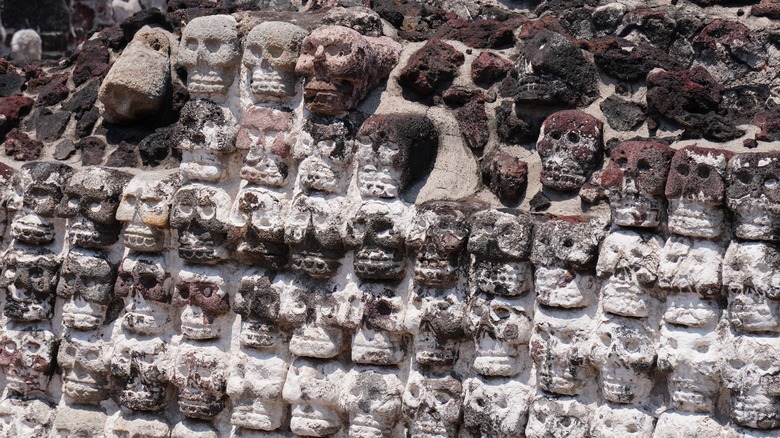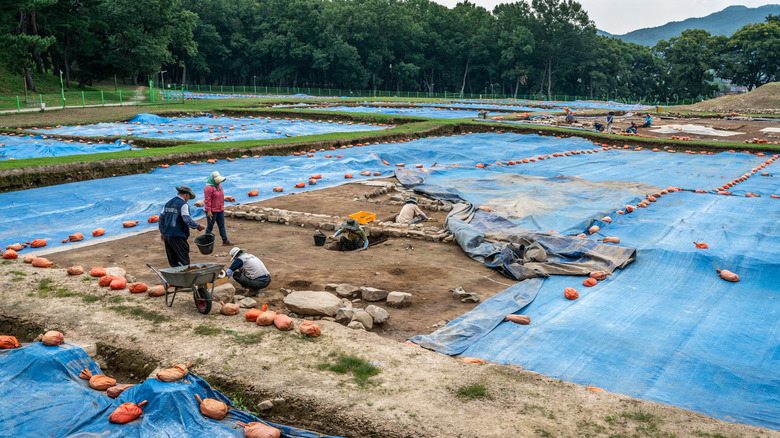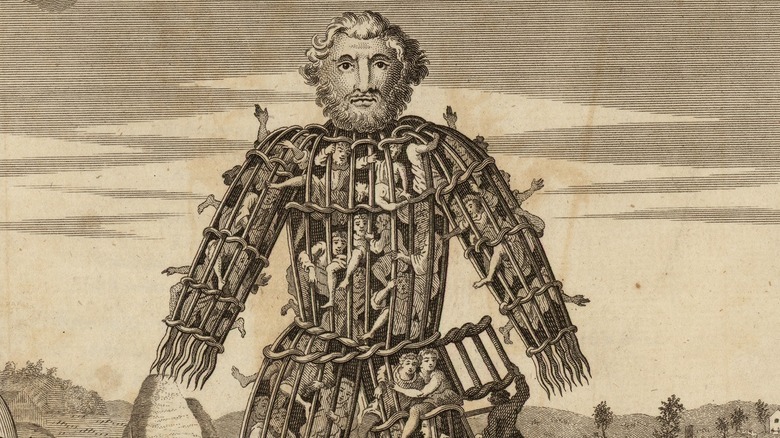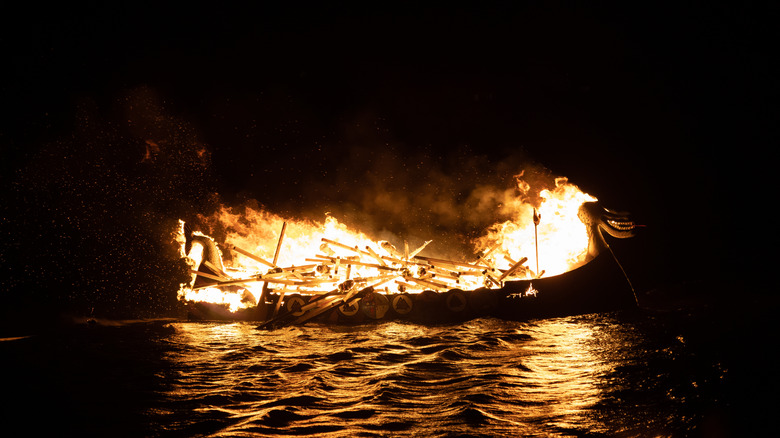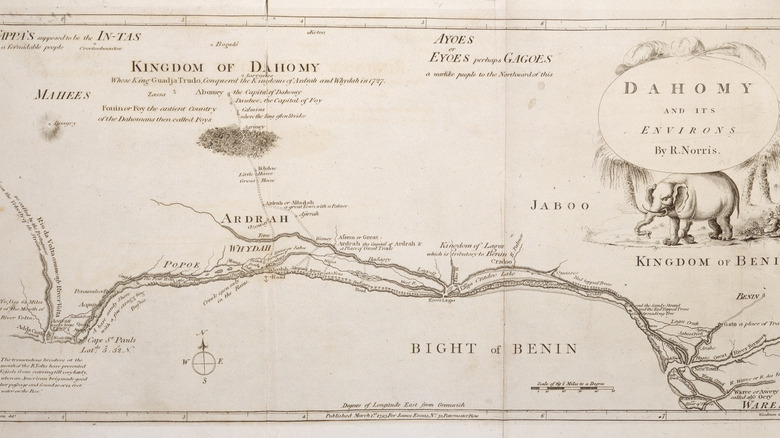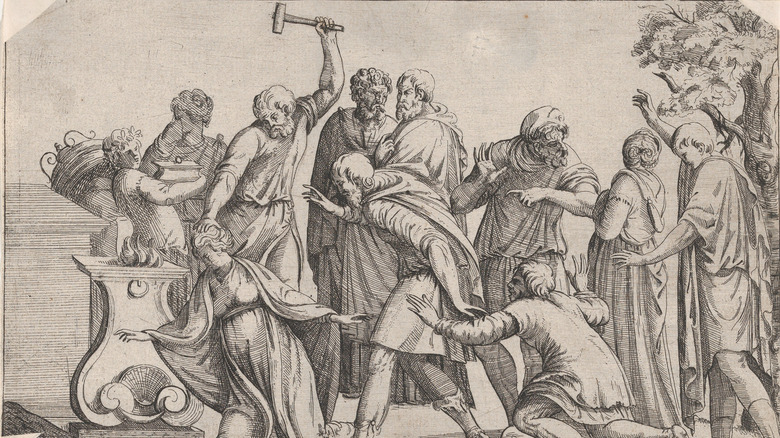The Most Shocking Stories Of Human Sacrifice In History
To many of us in the modern world, the idea of human sacrifice seems so strange and distant that it may as well be part of some half-remembered myth. Yet, there's no ignoring the evidence left by societies across time and the globe: human sacrifice really did happen. Whether it's physical clues excavated by archaeologists or written records from alleged eyewitnesses to sacrificial rituals, the sheer volume of it all means that we simply have to acknowledge that human sacrifice has happened.
That great number of cases also means that some sacrificial practices stand out for a variety of shocking reasons. A few are notable for the confounding number of people who may have been subjected to life-ending rituals, while others garner attention for the unique and protracted sequence of events that got people to a sacrificial site. For instance, the Incan children who were subject to mountaintop sacrifices now known as capacocha often went through months of good treatment and ritual preparation after they were selected for the rite, followed by a long hike to a cold and distant peak. Yet more cases of sacrifice have gone down in history for the striking ways in which remains were treated during or after the rite, leaving future humans to uncover the results centuries after the sacrifice was over and archaeologists to puzzle over their findings for generations.
Humans may have been sacrificed to accompany ancient Mesopotamian royals
Though it wasn't the very first city we know of in human history, the ancient Sumerian settlement of Ur now in the country of Iraq, is pretty darn old. Looking at the physical evidence, archaeologists now estimate that it was founded some 6,000 years ago. Perhaps nearly as old as the concept of cities and human settlements is the idea that someone should rule over it all. No surprise, then, that Ur had royals and a royal cemetery, where elites were buried in elaborate tombs filled with glittering gold jewelry and the bodies of retainers.
In one royal grave pit, 20th-century archaeologist C. Leonard Woolley found the bodies of several individuals, who he suggested were attendants who either sacrificed themselves or were killed to accompany a queen. But where Woolley guessed that they would have taken poison, a 21st-century examination of skulls from the cemetery indicates that at least some died from head wounds. Physical anthropologist Janet M. Monge told The New York Times that unique cracks in reconstructed skulls from the cemetery could only have happened in a still-living person.
What's more, the remains of soldiers and courtiers found with Ur's royals may not have been left alone. Research published in a 2015 issue of Antiquity claims that not only were some ritually killed with a puncture wound to the skull, but that their bodies were treated with mercury in an attempt to preserve them through a long funeral.
Ancient Egypt sent servants into the tomb with early pharaohs
For quite a while, archaeologists suspected that some of the earliest pharaohs of ancient Egypt sacrificed retainers to travel into the afterlife with them. But it wasn't until the 21st century that clear evidence emerged. In 2004, a joint research team composed of members from New York University, the University of Pennsylvania, and Yale excavated the graves of six individuals near the tomb of Aha, who ruled approximately 5,000 years ago. All appeared to have been buried at the same time in a large, shared grave. Archaeologists told The New York Times that the individuals were high-ranking people, including high-level government officials and skilled workers. Excavations have also revealed the remains of relatively young adults in oddly large numbers, which don't reflect common patterns of mortality for that era. Though there isn't clear physical evidence of sacrifice, it's suspicious enough that most researchers accept it as decent evidence of human sacrifice.
For those of the lower ranks, it simply wasn't practical to sacrifice large numbers of servants to accompany someone to the afterlife — or any at all, for that matter. The practice of retainer sacrifice appears to have died out sometimes in ancient Egypt's long-ago first dynasty, anyway. Instead, Egyptians increasingly buried their dead with small human figures known as shabti. These were believed to spring to life in the underworld, serving their masters in all manner of mundane tasks while the honored dead lounged about in the afterlife.
People of ancient Carthage may have sacrificed children
One of the most frightening sequences in the Hebrew scriptures outlines child sacrifice in the name of the god Moloch (also sometimes spelled Molech or Molek). On multiple occasions, books like Leviticus, Ezekiel, and Jeremiah speak harshly of the practice (though the story of Abraham's near-miss sacrifice attempt on his son Isaac indicates that the practice wasn't definitively out of the question with by the time of this particular patriarch).
Archaeological evidence indicates that fire-based child sacrifice may have been going on in ancient societies of the time. At one specific site in the Phoenician city of Carthage (now part of Tunisia), excavations at sacred sites known as tophets hint that sacrifice took place there. Cremated infant bones were placed in urns and buried at tophets, along with animal remains and inscriptions praising the gods.
This is an intensely controversial topic, however. It could be that these were burial sites for already-deceased individuals, some argue, while others say that the expensive cremations, number of remains, and inscriptions point to a darker conclusion. Even a close examination of the infant remains found at the Carthage tophet can yield seriously different conclusions. In a 2013 paper published in Antiquity, the writers argue that previous researchers got age estimates wrong and claim that there's good evidence infants were intentionally sacrificed at the site. A 2017 rebuttal replies that there's just too much uncertainty to go to the extreme conclusion that infant sacrifice definitely happened there.
Bog bodies may have been offerings to ancient European gods
Even if they got into the bogs by accident, the remains of people who had been placed in ancient peat bogs throughout Northern Europe are already deeply compelling and part of a crazy history of bog bodies. Because of the low-oxygen, high-acid, tannin-rich environment in these bogs, bodies can be remarkably well-preserved, with some millennia-old remains looking as if the person is merely asleep.
But, for some, their long rest in the dark, cold waters was no accident. One of the most famous bog bodies, Denmark's Tollund Man, was found with a noose still around his neck, almost certainly used to hang him. Britain's Lindow Man appears to have suffered an especially drawn-out death involving strangulation, stabbing, and drowning. He was submerged in the bog while still breathing — researchers working 2,000 years after his death found evidence that he inhaled water while dying. An examination of his stomach contents also showed that he consumed an oddly wide variety of seeds and grains, as well as mistletoe, shortly before his death, which may have been connected to an important agricultural ritual.
But why were these people being sacrificed, and to whom? In the Iron Age, when many communities lived or died by the harvest, pleasing the deities who were believed to manage the natural world would have been a big deal. And what could be more precious — and therefore pleasing to the gods — than to give them a human life?
Aztec priests assembled racks of skulls
Spanish conquistadors had a serious interest in justifying their often violent takeover of the Americas. Maybe the 16th-century Spanish reports of brutal human sacrifice and mountains of skulls in the Aztec city of Tenochtitlan were wildly overblown in an attempt to make conquistador Hernán Cortés and company look less brutish by contrast. Certainly, the accounts are shocking. As conquistador Bernal Díaz del Castillo — who entered Tenochtitlan with Cortés — wrote in his memoirs, he observed a tremendous pile of tens of thousands of human skulls near the city's temple.
Yet, as excavations in the modern metropolis of Mexico City have shown, the chroniclers weren't all that wrong. Archaeologists have uncovered more than 600 human skulls at a tower where they would have been displayed around the time of the Spanish conquest, near the central temple of Tenochtitlan known as Templo Mayor. They included female and male individuals, as well as adults and children, who were known to be sacrificed to the gods in bloody public rituals.
After death, the skulls of sacrificial humans would have been collected and displayed on racks known in indigenous Nahuatl as tzompantli. They also included the skulls of dead warriors, while the whole lot was regularly refreshed with the visages of new offerings. Archaeologists can reasonably guess that skulls uncovered throughout the region were part of tzompantli due to the large holes through the temples, which were part of the tzompantli-mounting process.
Some people may have been sacrificed as part of construction projects
Construction in the ancient world was serious business. Of course, people didn't want their buildings or bridges to collapse or otherwise fail. So, besides double-checking one's calculations, what's an ancient engineer to do? For some societies, ensuring a strong foundation apparently meant including a human sacrifice in the process.
At least, that's what the folklore says. Broadly known as foundation sacrifices, many tales claim that a living human had to be buried in the base of a new structure to appease local deities and allow the construction to stand. The dead person may even have been understood to transform into a protective spirit themselves. It's a chilling yet widespread story, with examples from Britain, eastern Europe, the Mediterranean, and India. In Japan, it was supposedly known as hitobashira, or human pillar, and required that a person be walled up in or near a water-based construction project such as a bridge or dam.
But did foundation sacrifice ever really happen? Quite possibly. In Korea, 2017 excavations at 1,600-year-old Wolseong castle revealed the remains of a 50-something man and woman inside the foundations. In 2021, further work uncovered a lone young woman buried nearby. Though there were no obvious sacrificial wounds or texts admitting to the practice, archaeologists now strongly believe that the three were placed there to act as appeasement or guardians for the castle.
Julius Caesar claimed Gauls sacrificed people in a wicker man
If you're a horror movie fan, you've probably already seen "The Wicker Man," be it the classic 1973 original with horror legend Christopher Lee or the less-lauded 2006 remake starring a whole lot of Nicolas Cage. In both films — spoilers for a movie that's been around for over 50 years — the protagonist is captured by the pagan inhabitants of a remote locale, then loaded into a giant human-shaped sculpture made out of wicker. The titular wicker man is then set aflame, with the unfortunate human still inside, as part of a sacrifice meant to boost the next harvest.
It may seem like a wild horror film invention, but there may have been a real wicker man human sacrifice ... at least if you asked Julius Caesar. In his "Commentaries on the Gallic War," Caesar claimed that the Gauls — members of a Celtic tribe who lived mostly in what's now France and who were defeated by Caesar in 50 B.C. — created massive human figures out of wicker, stuffed them full of real humans, and set the structure on fire to please their gods.
But can we believe Caesar? Rome often wanted to paint conquered people as savages and reports of human sacrifice were a handy way to demean other cultures. There are few other historical accounts, though the Greek historian Strabo wrote in his Geography that the Gauls used wicker men to sacrifice humans and animals.
Capacocha rituals sacrificed Inca children
The Inca Empire of South America, which began sometime before the 13th century and lasted until the 1532 conquest, was tremendously vast and complex. Its members also engaged in practices we may find shocking today, including child sacrifice known as capacocha. This months-long affair required provinces to send children deemed physically perfect, along with other tributes, to the capital of Cuzco. There, the children would be celebrated and then sent off on a long procession to a high-altitude site known as a huaca (shrine). There, they would be dispatched and placed in a grave. Some may have been sedated and then buried alive in the cold, low-oxygen environment.
The most dramatic physical evidence of the capacocha ritual is the three sets of remains uncovered on the Andean peak of Llullaillaco on the border between Argentina and Chile. In 1999, an archaeological team found the incredibly well-preserved mummies of three children at a huaca about 22,000 feet above sea level. Hair samples showed that the children once consumed peasant food, but then suddenly began enjoying a high-class diet with corn and meat, as well as significant amounts of coca and alcohol. The oldest of the group, a 13-year-old girl, consumed the highest amounts. The substance use for the older girl peaked shortly before her death, which may have made her less likely to resist her fate at the top of Llullaillaco. Another Andean mummy, known as the Ice Maiden, was also a likely victim of capacocha.
Vikings occasionally practiced human sacrifice
Vikings have become known for all sorts of things, from the faintly ridiculous (no, they didn't have horned helmets) to messed up things that happened during the Viking era, including human sacrifice. Those sacrifices were seemingly meant to please the gods. Evidence includes a Swedish picture stone that appears to show a human mid-sacrifice and the occasional appearance of human remains in ritual contexts.
Textual accounts also indicate that Viking communities engaged in human sacrifice, though early Christian chroniclers were invested in making the pagan Vikings look pretty darn bad. We do have a detailed account from a non-Christian source, the 10th-century Muslim chronicler and diplomat Ibn Fadlan. While traveling in what's today Russia, he encountered a Viking group known as the Rus and witnessed an elaborate funeral of one of their nobles.
In Fadlan's account, the high-ranking man's death meant he was to be accompanied into the afterlife by one of his slaves. From that group, one woman volunteered and was feted with food, drink, and two servants of her own. But the price she paid for the short period of good treatment was to be harsh. Fadlan wrote that, in the lead-up to the man's funeral, she was sexually assaulted, asked to gaze into the afterlife, drugged, and finally ritually killed while lying next to the body of the high-ranking man in his beached boat. Once done, the craft was set on fire and, afterward, the ashes were covered with a large burial mound.
Human sacrifice was reportedly central to the kingdom of Dahomey
From the 17th century into the first few years of the 20th century, the West African kingdom of Dahomey was a major power, rising to prominence through warring and its participation in the slave trade. As European colonizers established footholds in Africa, they began to tell horrific stories of human sacrifice in Dahomey. Some even alleged that enslaving people and taking them away from their homes was actually doing them a favor — at least they wouldn't be sacrificed, proponents argued. An 1860 address to the U.K. House of Commons claimed that the planned sacrificial rites of the kingdom would take 2,000 lives and create a small lake of human blood.
Yet, could the stories of bloody human sacrifice in Dahomey have been exaggerated to support pro-slavery and colonialist causes? An objective look at historical records greatly undermines the colonialist narrative. At the same time, it's hard to completely deny accounts of human skulls displayed at the royal palace. Some of these apparently came from real human sacrifices, including captured enemy combatants. Sacrifice was a major part of the religious rites of the kingdom, with human sacrifice representing an especially important offering to the gods. But the tales of massive sacrificial rites and cannibalism were almost certainly fabricated (perhaps even by the Dahomeans themselves, who could have found value in being portrayed as fearsome cannibals to their neighbors).
Ancient Greeks may have sacrificed people
The relationship between ancient Greek societies and human sacrifice was complicated. Some legends condemn the practice, as in the tale of King Lycaon, who attempted to serve the flesh of his own son to the god Zeus. The infuriated deity turned Lycaon into a wolf. However, Greek writer and traveler Pausanias also claimed that Zeus was honored by Lycaean rites that included human sacrifice (and that accidental consumption of human flesh temporarily turned one worshiper into a wolf). Other myths say that Agamemnon sacrificed his daughter Iphigenia to ensure success in the Trojan War, while the legend of the Minotaur claims that Athenian youths were sent into the creature's labyrinth as bloody tribute.
While that may have remained an eye-widening legend dismissed against the notion of ancient Greece as a reasonable, civilized sort of place, archaeologists have once more uncovered real evidence that supports the story of ancient Greek human sacrifice. In 2016, Greek authorities announced that excavations on Mount Lykaion had uncovered the remains of a teenage boy. While there weren't clear indications on the bones that he had been sacrificed, the site has been long known as one dedicated to Zeus and where worshipers did sacrifice animals to the god. In 2017, excavators on the island of Crete found the skull of a young girl that, judging by the intentional disassembly of the bones and some geographic research, appeared to have been sacrificed in response to a devastating earthquake.
